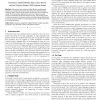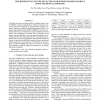28 search results - page 2 / 6 » Parallel Hidden Markov Models for American Sign Language Rec... |
ICPR
2006
IEEE
14 years 6 months ago
2006
IEEE
Coarticulation is one of the important factors that makes automatic sign language recognition a hard problem. Unlike in speech recognition, coarticulation effects in sign language...
ASSETS
2006
ACM
13 years 11 months ago
2006
ACM
CopyCat is an American Sign Language (ASL) game, which uses gesture recognition technology to help young deaf children practice ASL skills. We describe a brief history of the game...
PAMI
1998
13 years 4 months ago
1998
—We present two real-time hidden Markov model-based systems for recognizing sentence-level continuous American Sign Language (ASL) using a single camera to track the user’s una...
ICASSP
2008
IEEE
13 years 11 months ago
2008
IEEE
We address the feature selection problem for hidden Markov models (HMMs) in sequence classification. Temporal correlation in sequences often causes difficulty in applying featur...
ICMI
2005
Springer
13 years 10 months ago
2005
Springer
Sign language recognition (SLR) plays an important role in human-computer interaction (HCI), especially for the convenient communication between deaf and hearing society. How to e...


